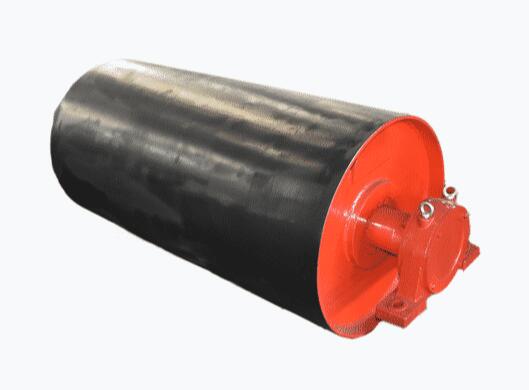bend pulley
Type: Reversing drum for belt conveyor
Diameter: 250-1000mm
Length: 500-1400mm
Weight: 150-3000kg
Applicable Machinery: Belt Conveyor
Applicable bandwidth: 500-1400mm
Introduction: The directional roller, also known as the guide drum, is a common key component of belt conveyors. It is mainly used to change the direction of the conveyor belt or to press the conveyor belt to increase its wrap angle with the drive drum. The characteristics of the directional roller are compact structure, light weight, low occupation, and high performance
product details
The directional roller, also known as the guiding drum, is a common key component of belt conveyors, mainly used to change the running direction of the conveyor belt or press the conveyor belt to increase its wrap angle with the transmission drum.
characteristic
The reversing drum has the characteristics of compact structure, light weight, low occupation, reliable performance, beautiful appearance, safe and convenient use, and can still work normally under harsh conditions such as high dust and wet mud.
classification
(1) The reversing drum is also divided into light, medium, and heavy types according to its bearing capacity. The grading diameters are 50-100mm, 120-180mm, and 200-260mm. The structural type is consistent with the transmission drum.
(2) The reversing drum is used to change the direction of the conveyor belt and is generally placed at the tail or vertical tensioning device when changing direction 180 degrees. The 90 degree directional change is placed above the vertical tensioning device, and the surface increasing roller is generally used in situations where the angle is less than or equal to 45 degrees.
(3) There are two types of roller covers for changing direction: exposed steel surface and smooth rubber surface.
Transporting goods: cardboard boxes, pallets, wooden boards, etc
Bearing grade: Semi precision bearing
Structural features: Composed of carbon steel galvanized stamped bearing components and outer tube press fit
Axis: Cold drawn round tube (galvanized if special requirements apply), stainless steel
Surface treatment of cylinder: In addition, it can be coated with glue or polyurethane
Features: Extremely flexible and smooth rotation, low noise

About the rubber coated roller
The rubber drum is an important component and constituent part of the belt conveyor transportation system. The rubber coating of the drum can effectively improve the operation of the conveyor system, protect the metal drum from wear, prevent the conveyor belt from slipping, and ensure the synchronous operation of the drum and belt, thereby ensuring the efficient and high-capacity operation of the belt. The rubber coating of the drum can effectively prevent sliding friction between the drum and the belt, reduce material adhesion on the surface of the drum, and thus reduce belt deviation and wear. It is widely used in industries such as steel, metallurgy, coal, cement, power generation, fertilizer, grain storage, and ports.
Adhesive material
Natural rubber, nitrile rubber, chloroprene rubber, EPDM rubber, polyurethane, etc. can be used.
technology
The rubber wrapping drum technology can be divided into two categories. Traditional rubber wrapping techniques, such as hot vulcanization, mainly use vulcanization tanks to vulcanize the rubber with the drum to ensure the bonding strength between the rubber wrapping panel and the drum. The second type is cold vulcanization technology, which uses a special cold vulcanization method to directly bond the drum and the rubber wrapping panel, allowing for on-site and underground rubber wrapping. This technology is more advanced and greatly reduces labor costs.
The reversing drum is used to change the direction of the conveyor belt or increase the wrap angle between the conveyor belt and the drive drum.
The various components of the drum
- Roller shaft: Generally, round steel made of 45 # steel and 40Cr is used for processing. (Material production can also be based on customer requirements)
Cutting of drum shaft – already cut drum shaft material -45 # steel drum shaft – machine tool processing – rough machined drum shaft – precision machined drum shaft.
- Shaft sleeve: made of 45 # steel – drum cast steel shaft sleeve – drum specific expansion sleeve
- Drum connection: Expansion sleeve is connected to drum shaft – steel key is connected to drum shaft
There are two types of drum welding, one is common manual welding, and the other is CO2 gas shielded arc welding machine welding. Artificial welding is processed using an AC welding machine, which has a relatively slow processing speed and requires frequent replacement of welding rods. Our company has introduced a roller specific Co2 gas shielded arc welding machine, which has a faster welding speed, no porosity, and is aesthetically pleasing compared to manual welding. At the same time, it greatly reduces manpower and other characteristics.
- Roller specific bearings: self-aligning ball bearings – roller specific self-aligning bearings – self-aligning bearings installed on the roller.
- Bearing seat: The bearing seat of the drum is divided into two types according to the material, one is cast iron material, used for light and medium-sized drums. Another type is cast steel material, used for heavy-duty rollers.
Smooth surface roller without bearing seat – pressure roller roller – rubber coated roller – herringbone rubber coated roller – rubber coated directional roller – exposed smooth steel surface roller – brass nozzle
 Hebei Hengya Conveyor Equipment Co., Ltd
Hebei Hengya Conveyor Equipment Co., Ltd